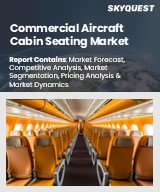
세계 민간항공기 객실 좌석 시장 규모는 2023년에 75억 달러로 평가되었으며, 2024년 80억 2,000만 달러에서 2032년에는 136억 7,000만 달러로 성장하여 예측 기간(2025-2032년) 동안 CAGR 6.9%로 성장할 전망입니다.
세계 민간 항공기 객실 좌석 시장은 여객 수송량 증가, 항공기 현대화, 경량화 및 연비 효율이 높은 좌석에 대한 수요에 힘입어 강력한 성장세를 보이고 있습니다. 항공사들은 객실 공간을 최적화하고 운항 비용을 절감하는 동시에 승객의 편안함을 우선시하는 혁신적인 좌석 설계에 투자하고 있습니다. 신흥 시장에서의 항공 여행의 확대는 항공사가 경쟁력을 유지하기 위해 인테리어를 개선하려는 수요를 촉진하고 있습니다. 또한, 프리미엄 클래스의 인기가 높아짐에 따라 각 제조사들은 인체공학, 모듈식 디자인, 기내 연결 편의시설 강화에 주력하고 있습니다. 제조 비용 상승, 엄격한 규제, 공급망 혼란 등의 문제에도 불구하고, 이 시장은 앞으로도 계속 성장할 것으로 보입니다. 지속가능하고 맞춤형 좌석 솔루션은 승객의 경험을 향상시키고 항공사의 수익성을 개선할 수 있는 여건을 마련하고 있습니다.
Global Commercial Aircraft Cabin Seating Market size was valued at USD 7.5 billion in 2023 and is poised to grow from USD 8.02 billion in 2024 to USD 13.67 billion by 2032, growing at a CAGR of 6.9% during the forecast period (2025-2032).
The global commercial aircraft cabin seating market is witnessing robust growth driven by rising passenger traffic, fleet modernization, and a demand for lightweight, fuel-efficient seating. Airlines are investing in innovative seat designs that prioritize passenger comfort while optimizing cabin space and reducing operational costs. The expansion of air travel in emerging markets is boosting demand as airlines renew their interiors to remain competitive. Additionally, the increasing popularity of premium seating classes is prompting manufacturers to focus on ergonomics, modular designs, and enhanced in-flight connectivity amenities. Despite challenges such as high manufacturing costs, stringent regulations, and supply chain disruptions, the market is set to thrive. Sustainable, customizable seating solutions are poised to elevate the passenger experience and improve airline profitability.
Top-down and bottom-up approaches were used to estimate and validate the size of the Global Commercial Aircraft Cabin Seating market and to estimate the size of various other dependent submarkets. The research methodology used to estimate the market size includes the following details: The key players in the market were identified through secondary research, and their market shares in the respective regions were determined through primary and secondary research. This entire procedure includes the study of the annual and financial reports of the top market players and extensive interviews for key insights from industry leaders such as CEOs, VPs, directors, and marketing executives. All percentage shares split, and breakdowns were determined using secondary sources and verified through Primary sources. All possible parameters that affect the markets covered in this research study have been accounted for, viewed in extensive detail, verified through primary research, and analyzed to get the final quantitative and qualitative data.
Global Commercial Aircraft Cabin Seating Market Segments Analysis
Global Commercial Aircraft Cabin Seating Market is segmented by Class, Seat Type, Component and region. Based on Class, the market is segmented into Economy Class, Premium Economy Class, Business Class and First Class. Based on Seat Type, the market is segmented into 9G Seats, 16G Seats and 21G Seats. Based on Component, the market is segmented into Structure, Foams, Actuators, Electrical Fittings and Others. Based on region, the market is segmented into North America, Europe, Asia Pacific, Latin America and Middle East & Africa.
Driver of the Global Commercial Aircraft Cabin Seating Market
One of the key market drivers for the global commercial aircraft cabin seating market is the increasing demand for enhanced passenger comfort and experience. As airlines strive to differentiate themselves in a competitive landscape, they are investing in innovative seating designs and materials that offer improved ergonomics, more legroom, and advanced features such as in-flight entertainment systems and connectivity options. This push for modernization is further fueled by growing passenger expectations for comfort during flights, leading airlines to upgrade existing seating layouts and invest in new aircraft, thereby driving growth in the cabin seating market.
Restraints in the Global Commercial Aircraft Cabin Seating Market
One of the key market restraints for the global commercial aircraft cabin seating market is the stringent regulatory environment surrounding aircraft safety and comfort standards. Manufacturers must comply with a variety of certifications and safety protocols, which can significantly increase production costs and lead to delays in product development. Additionally, the unique specifications imposed by airlines for seat design and functionality can restrict the scalability and innovation of seating solutions. Coupled with rising material costs and the demand for sustainable practices, these factors can hinder market growth and limit profitability for manufacturers in the competitive landscape.
Market Trends of the Global Commercial Aircraft Cabin Seating Market
The Global Commercial Aircraft Cabin Seating market is experiencing a pronounced shift towards lightweight and sustainable seating solutions, driven by airlines' increasing focus on enhancing fuel efficiency and reducing operational costs. Manufacturers are responding to this demand by utilizing advanced materials such as composites, titanium, and recycled components, which not only decrease the overall weight of the aircraft but also align with global sustainability initiatives. This movement reflects a broader industry commitment to environmental responsibility, as airlines seek to optimize their cabin layouts while meeting passenger comfort needs. The integration of eco-friendly innovations in seating represents a significant market advancement, fostering growth and transformation in the sector.